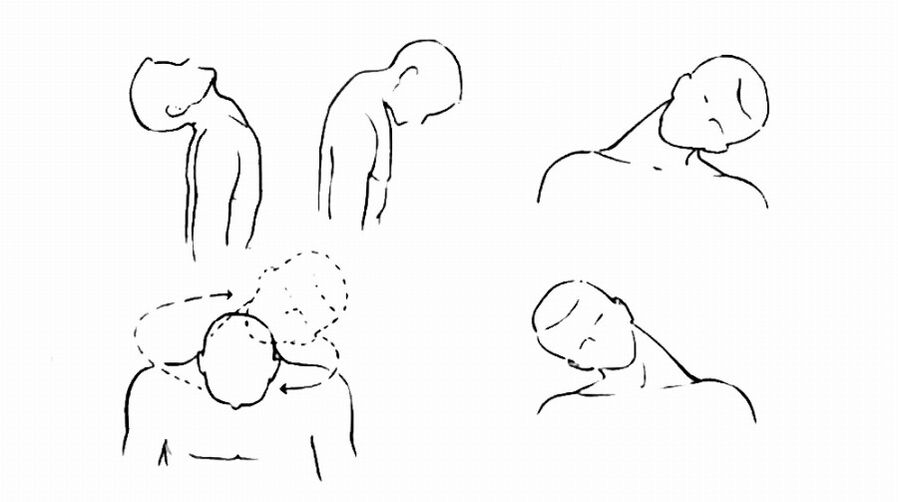In middle-aged women and men, osteochondrosis (CS) of the cervical spine is most often diagnosed because this stage is more sensitive to stress. The first signs of the disease are often not expressed, making it difficult to identify the problem in the early stages of development. Manifestation of osteochondrosis is caused by a number of factors affecting the body. In order to have an appropriate treatment regimen for cervical osteochondrosis, it is important to find out the causes of the incidence.

The main causes of the disease
Cervical osteochondrosis is a pathology of a degenerative-dystrophic nature in which the tissues of the intervertebral discs of the neck collapse due to negative factors. Over time, the disease also affects other structures in the spine, resulting in impaired function. The person begins to be disturbed by unpleasant symptoms, the state of health gradually deteriorates.
The main cause of vertebral degeneration is a violation of metabolic functions in the body. Vertebrae and intervertebral structures do not receive the necessary nutrients and elements. Osteophytic bone growth appears on the bone tissue. Osteoporosis spreads over time. Initiated osteochondrosis leads to the fact that the cervical spine is immobilized due to fusion of the vertebrae.
The triggering mechanism for the development of such processes is the negative factors that constantly affect the human body. The causes of osteochondrosis are:
- congenital pathologies of the musculoskeletal system,
- hereditary predisposition,
- heavy physical activity,
- passive lifestyle,
- violation of posture,
- back injuries
- scoliosis,
- stress, nervous overload,
- complication after severe infectious diseases.
Extent and manifestation of the disease

Signs of osteochondrosis of the cervical spine develop gradually. As the pathology progresses, the symptoms become more pronounced. There are 4 stages in the development of chondrosis:
- At 1 degree, osteochondrosis has no obvious symptoms. Sometimes a headache can be bothersome as well as a discomfort in the neck. After resting, the symptoms go away quickly, but the degenerative processes in the cartilage discs have already begun, during which the integrity of the nucleus pulposus is disrupted.
- When the pathology has progressed to stage 2, the intervertebral cartilage is covered with cracks through which the nucleus of the cartilage disc comes out. The intervertebral space decreases and the patient complains of chronic pain syndrome.
- In stage 3 of progression, osteochondrosis of the cervical spine is characterized by severe vertebral and headache. Because of hypoxia, brain cells suffer, a person may experience temporary limb paralysis, hearing and vision problems. Hernias appear in the neck area that compress the nerves, muscles, arteries, and veins.
- As the disease progresses to the last (4 tablespoons), the symptoms of cervical osteochondrosis in men and women become so pronounced that the patient is unable to rest and rest for even a minute. Osteophytes develop on the vertebrae, which impairs neck mobility and makes the person disabled. If complex treatment is not started at this stage, the situation could end in death.
Typical symptoms
Conservatively, 1-2 degrees of osteochondrosis can be effectively treated. In advanced cases, it is difficult to completely restore destroyed intervertebral structures. This means that it is important to diagnose the disease at an early stage. Therefore, a doctor should be consulted immediately if a person has similar symptoms:
- acute pain localized in the neck, shoulders, back of the head,
- severe headache and dizziness due to compression of the nerves and blood vessels in the cervical spine,
- impairment of visual and auditory functions,
- muscle weakness
- numbness, feeling like goosebumps running down the skin
- malfunction of the vestibular device.
At the level of C4-C6 vertebrae, cervical osteochondrosis is characterized by impaired sensitivity of the upper extremities, hands, and fingers. If the vertebrae in the artery are compressed, dangerous disorders in the brain are bothersome. Hypoxia occurs due to insufficient blood supply and nutrition to brain cells. If the patient is not treated in time, memory problems will occur, swallowing function will be impaired, and squeezing in the throat where the Adam's cob will be located will be disruptive.
Often, even a person’s voice changes and cardiac pathologies occur with the progression of cervicothoracic osteochondrosis.
How is the diagnosis made?

If a person suspects that he or she is developing osteochondrosis of the cervical vertebrae, he or she should visit a neurologist who will perform an initial examination and try to find out the main causes of the disease. During palpation, it is possible to determine approximately the stage of the pathology - with or without displacement. To confirm the diagnosis, the patient must perform a number of such instrumental diagnostic tests:
- Radiography. It helps to determine the growth rate of osteophytes, the size of the gap between the joints.
- MRI or CT. It allows the rate of destruction of intervertebral discs as well as the assessment of the condition of other soft structures.
- Doppler ultrasound. It helps to identify abnormalities in the functioning of blood vessels, which can damage the blood supply to the brain.
How do we handle the problem?
If the diagnosis is confirmed during the diagnosis, the doctor will select the optimal treatment regimen for cervical osteochondrosis based on the results obtained. If the disease is not started, you can get rid of it with medications and additional procedures. Stages 3-4 are often helpless, the best solution in this case is surgery.
Effective medicine
Medical treatment for osteochondrosis of the cervical spine in the acute period is primarily aimed at relieving inflammation, swelling, and pain. For this purpose, the following groups of drugs are prescribed:
- Non-steroidal anti-inflammatory drugs. Eliminates inflammation, reduces swelling, relieves pain. If the pathology worsens, it is recommended to use it as an injection, when the symptoms are slightly relieved, tablets can be taken.
- Analgesics.
- Muscle relaxants. It relieves muscle cramps, freeing nerves and blood vessels.
- Chondroprotection. They restore damaged cartilage structures and prevent their further destruction. For a positive effect, it is recommended to take drugs in this group for a long time.
- vasodilators. They help improve blood flow, which normalizes the brain’s nutrition.
- Group B vitamins. They normalize the metabolism in the body, stimulate the immune system, allowing the soft and bone tissues to regenerate faster.
Complex training therapy

Therapeutic exercises can be used to quickly restore the affected structures of the cervical spine. You can cure the disease in the following ways:
- the head turns in different directions,
- rotating movements,
- shoulder rotation,
- raising and lowering the head.
Physiotherapy and massage
Cervical osteochondrosis can be successfully treated with physiotherapy procedures prescribed by a doctor, taking into account the specific characteristics of the body. In most cases, the following courses are recommended:
- magnetic therapy,
- laser heating,
- ultrasound,
- electrophoresis,
- use of ozokerite,
- hydrogen sulphide and radon baths,
- ultraviolet radiation.
It is helpful to take a therapeutic manual massage course to overcome osteochondrosis of the cervical spine. The procedure should be performed by a qualified physician who is familiar with the diagnosis and x-rays. Thanks to puncture, caressing, groping and vibration, normal blood circulation and feeding of the damaged areas will be restored.
Treatment with folk remedies

Cervical osteochondrosis cannot be treated by conventional methods, but a doctor should be consulted first. A compress made according to this recipe will help relieve pain, inflammation and swelling:
- Wash the cabbage leaves, cut the coarse fibers and knead well.
- Apply a mixture of honey and aloe juice (2: 1) to the leaf, spread evenly on the surface.
- Heat the compress over steam, then apply to the neck, secure with foil and wool scarf.
- Wear a bandage for 3-4 hours.
It is recommended to make a compress daily - morning and evening.
Prevention and prognosis
With timely and appropriate treatment, the disease can be cured and complications prevented. If the problem is not treated and the doctor’s advice is ignored, the prognosis for recovery is disappointing. An active lifestyle, monitoring posture, exercise, proper nutrition, and medical attention should be sought to prevent cervical osteochondrosis.



















